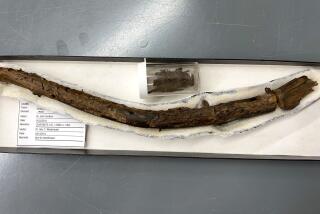Russian scientists revive an ice age flower
A plant that was frozen in Siberian permafrost for about 30,000 years has been revived by a team of Russian scientists — and borne fruit, to boot.
Using tissue from immature fruits buried in fossil squirrel burrows some 90 feet below the surface, researchers from the Russian Academy of Sciences in Pushchino managed to coax the frozen remains of a Silene stenophylla specimen into full flower, producing delicate white blooms and then fruit.
The findings, published this week in the journal Proceedings of the National Academy of Sciences, describe what is a record for reviving presumably dead plant tissue — and may provide clues as to what makes some plants hardier and longer-lived than others.
“I’m absolutely thrilled with the result,” said Grant Zazula, a paleontologist with the Yukon government in Canada who reviewed the study for the journal. “I’ve always been excited for the potential of something like this being successful.”
The Arctic tundra holds a trove of ancient organic material — from tiny spheres of pollen to giant mammal bones — that can tell scientists much about what the ecosystem there looked like tens of thousands of years ago. But it’s not as well-studied as it could be, Zazula said, because icy realms like northeastern Siberia are exceedingly hard to reach.
The fruits of these ancient plants — a species known commonly as the narrow-leafed campion that still grows in Siberia and northern Japan — were excavated a few years ago from a bank of the lower Kolyma River.
Bacteria and other simple organisms had been known to survive in the ice for thousands of years. But reviving a life form as complex as a plant is an entirely different matter, scientists said.
“It is like generating a dinosaur from an ancient egg,” said Jane Shen-Miller, a plant biologist at UCLA who has sprouted a 1,300-year-old lotus seed.
For this study, however, the researchers managed to grow a plant without even using a seed. Instead, they thawed, washed and disinfected the fruits and took out bits of nutrient-rich fruit flesh known as placental tissue. When bathed in the right broth of chemicals, placental tissue acts like the plant version of stem cells — it can be instructed to grow into specific plant organs or, in this case, whole plants. After those plants fertilized each other, they were able to flower and bear fruit.
There were a few interesting differences between these ancient plants and the modern relatives also grown as part of the experiment. The ancient ones produced 1.5 to 2 times as many buds but were slower to grow roots. The petals on the ancient flowers were narrower than the modern petals, and some of the blooms were exclusively female — unlike the modern flowers, which had both male and female parts.
Zazula said he was eager to see scientists compare the DNA from the ancient and modern specimens to pinpoint the genetic changes that were responsible for the plant’s evolution. “That’s completely unheard of before,” he said.
If scientists can find the genes that made these plants able to withstand harsh conditions over thousands of years, they might be useful in developing hardier crops, scientists said.
The study is an encouraging sign that it may be possible to revive larger and more complex beings that were preserved in the frozen tundra.
“This whole thing about bringing back woolly mammoths and large extinct animals — this kind of opens the doors on that front,” Zazula said.
The study was led by Svetlana Yashina of the Russian Academy of Sciences. Corresponding author David Gilichinsky died last week, days before the paper’s publication.







